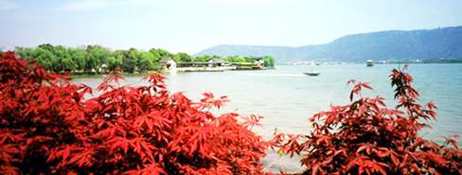
Shanghu Lake
Shanghu was named after Jiang Shang (1128-1015 B.C.), known more popularly as Jiang Taigong, a legendary man of great wisdom who once fished by this lake when he was fleeing the tyranny of the Shang dynasty. Jiang Shang helped Zhou Wenwang found the Zhou dynasty (1101-221 B.C.), the longest-reigning dynasty in not only China but also the world. Today, Jiang’s stone statue adorns the shimmering Shanghu, holding a fishing pole without a hook and bait. The metaphor of “Jiang Taigong fishing” has been an inspiration for Chinese over the centuries.
Shanghu, embraced by verdant hills called Yushan, is about twice the size of Hangzhou’s West Lake. Local residents are proud of the “gem” that makes their city shine. More importantly, they take great pride in their efforts to revive the lake which was all but dead and disappeared during the Cultural Revolution four decades ago.
At the height of the Great Cultural Revolution in the 1960s, Shanghu was the victim of a nationwide campaign to “dry up the lake for farmland”. Mao Zedong’s call for waging a relentless struggle against Mother Nature was answered with zeal and frenzy by mesmerized masses and Red Guards who toiled with bare hands to fill the lake with rocks and stones removed from Yushan, which was left with an ugly scar. It was not until 1985, almost a decade after the end of the “10-year turmoil,” the codeword for the Cultural Revolution, that the people realized the enormity of the mistakes they had committed. The farmland thus created turned out to be inappropriate for farming, and the ecosystem was irrevocably destroyed.
Before long, Changshu’s leadership made an over-arching decision to revive the dead lake by flooding it with water from the Yangtze River. After a couple of years, Shanghu was reborn to become, once again, a tourist attraction. It has also become a favorite resort for multinationals in nearby Shanghai.
|


